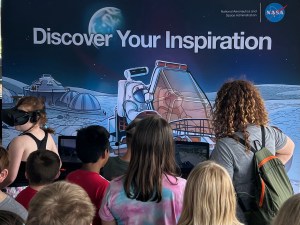Imagine being transported to the other side of the solar system simply by putting on a pair of glasses. Now imagine bringing along real NASA engineers to help you on your mission.
Students at Shasta High School in Redding, California, had just that opportunity as they worked virtually with NASA engineers to develop concepts for new science missions to the deep solar system.
“Our goal is to inspire the next generation of explorers – including those who don’t have access to NASA centers nearby – to pursue careers in space, technology, and engineering,” said Concha Reid, deputy program manager for NASA’s Radioisotope Power Systems (RPS) Program. “This pilot program gave the students the real-world mission-planning experience of working together and overcoming differences to achieve mission success.”
Students from Shasta’s Space Science and Engineering class worked with students from its Computer-Aided Drafting (CAD) class for two months to produce a comprehensive and realistic space mission supported by the science, engineering, and physical constraints of the spacecraft.
Powering a spacecraft to some of the deepest, darkest, and dustiest destinations in the solar system requires the use of a nuclear “battery,” called a radioisotope power system. Members of the RPS Program at NASA’s Glenn Research Center in Cleveland virtually met with students throughout the project to guide them through the mission planning process and to help them understand the complexities of space travel and the enabling power of RPS.
Shasta High School invested in cutting-edge technology, such as Microsoft’s HoloLens augmented reality headsets that enabled them to collaborate directly with NASA. Students loaded the 3D models they designed into a virtual environment. NASA engineers from across the country provided feedback in real-time as if they were in the same room.
Working with NASA gave students a deeper understanding of the vast complexity of space exploration and the importance of working as a team to accomplish a common goal.
“The quality of work produced by the students showed how invested every student was in the project,” said educator Brian Grigsby. “Many students recognized the importance of their work and how it will shape their future career choices…pursuing STEM related careers as a result.”
“Projects like this allow students to take concepts they learned in class and apply them to solve problems,” educator Bret Barnes said. “This project was truly relevant and pushed students to collaborate, problem solve, and design a mission in a very short period of time.”
This pilot program is a model for future programs at Shasta High School and for other schools around the nation that want to give students more access to NASA.
Kristin Jansen
NASA Glenn Research Center
Kerri Beisser
NASA Glenn Research Center/ Aerospace Corporation




























